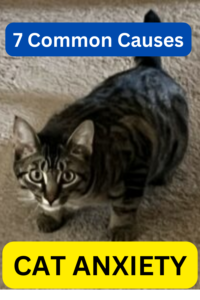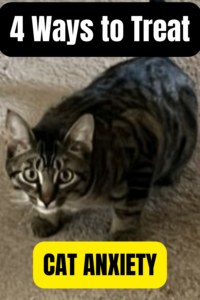Cat anxiety is a serious issue and should never be ignored. Untreated cat anxiety can result in unwanted behaviors and health issues. Learning about what cat anxiety is and also how to treat it is important for both you and your cat.
In this post, we’ll cover:
-
- Symptoms of Cat Anxiety
- Causes of Cat Anxiety
- Cat Separation Anxiety
- Cat OCD (Obsessive Compulsive Disorder)
- How to Treat Cat Anxiety
- Two eBooks to Help with Cat Care and Health and Cat Training
Watch My Video: What is Cat Anxiety?
This post contains affiliate links. If you make a purchase, I’ll earn a commission (at no extra cost to you). As an Amazon Associate, I earn from qualifying purchases. I donate 10% of my earnings to animal charities.
Symptoms of Cat Anxiety
According to PetMd, common signs of cat anxiety can include:
-
- Withdrawal and hiding
- Trembling
- Trying to escape
- Becoming less active
- Diarrhea
- Destructive behavior
- Aggressive behavior
- Not using the litter box
- Sores on their skin from overgrooming
- Loss of appetite
- Excessive meowing
- Weight loss
- Restlessness
- Lethargy
- Repetitive or compulsive behaviors
- Pacing
7 Common Causes of Cat Anxiety
1. Fear. Cats can get anxious when they anticipate danger.
2. Pain or illness. Remember that cats will usually try to hide this, so by the time you’re seeing signs, it may be quite serious.
3. A traumatic experience. This can be as serious as past abuse, or as minor as someone startling them while they were in the litter box.
4. Exposure to infectious diseases or something toxic.
5. Lack of socialization or neglect.
6 Age. Just like humans, cats can experience anxiety-causing things like memory loss and confusion. Joint pain or arthritis can also cause your cat to be anxious.
7. Changes. Big changes such as moving or a new person, baby, or pet coming into the house. Or small changes like the location of their litter box or food dishes.
Cat Separation Anxiety
This is one of the most common forms of cat anxiety. This will be apparent if your cat is fine as long as you’re at home, but becomes stressed or anxious when you leave (the house, or even the room).
Cat separation anxiety is common among cats who have been adopted, who were abandoned, or have been passed from home to home.
Check out my post, Separation Anxiety in Cats for more information (includes video!)
Obsessive Compulsive Disorder (OCD)
This should be considered if your cat is doing repetitive or exaggerated behaviors such as obsessive grooming, pacing, excessive meowing or chewing on fabric. The causes of OCD in cats aren’t fully known, but it is thought that OCD is considered a mental disorder and can also be brought on by stress.
Sometimes we make this worse by giving our cats attention when they’re doing the compulsive behaviors.
4 Ways to Treat Cat Anxiety
1. Call the vet first. If you think your cat is exhibiting signs of cat anxiety, you should make an appointment with your veterinarian. It’s important to rule out any health issues or toxins first.
Because cats typically hide pain and illness, your vet may have to do blood work or other tests to determine if a medical or health issue is causing your cat’s anxiety.
If it’s a health issue causing your cat’s anxiety, your vet can help solve it.
2. Never punish your cat. Don’t scold or punish your cat for their anxious behavior. This will only make it worse instead of better.
3. Help them feel safe and relaxed in their surroundings.
4. Reduce their stress. For information about what might be causing stress for your cat, read my article, Cat Stress Relievers – 10 Things That Stress Your Cat Out!
For more information on exactly how to help your cat with anxiety, read this article, Managing Anxiety in Cats.
Cat Anxiety Should Not Be Ignored
If left untreated, cat anxiety will probably get worse and result in unwanted behaviors becoming worse as well. It can result in chronic stress which can affect your cat physically and psychologically.
Just like with humans, their immune system can be compromised, making them more vulnerable to illness, and severe depression can develop as well. It’s important to create a peaceful home for your cat and take signs of cat anxiety seriously.
For Help with Cat Care and Health
The Complete Cat Health Care Guide from the folks at Kingdom of Pets not only covers cat health questions, but also covers all aspects of cat care, including how to create a loving relationship with your cat. You can read my complete review here.
For Help with Cat Training
If you feel you need more help with your cat’s behavior, I can recommend this eBook called, Complete Cat Training Guide from KingdomofPets.com.
It provides step-by-step instructions to solve 25 common cat behavior issues. It also covers cat separation anxiety.
You can read my complete review here.
Cat Behavior Problems
- How to Stop a Cat from Biting
- How to Stop a Cat from Scratching Furniture
- How to Stop a Cat from Spraying
- How to Stop a Cat from Urinating on the Bed
- How to Get Your Cat to Use the Litter Box and Why They Won’t
- Aggressive Cat Behavior
- How to Stop Cats from Fighting
I Donate to Animal Charities
I hope the tips in this post helped you to understand cat anxiety and get it solved for your cat!
Thank you for visiting my website. I donate 10% of my profits to animal charities. You can see a list of the charities I donate to here.
If you like this website, please share it with other pet lovers. Thank you! Debra













